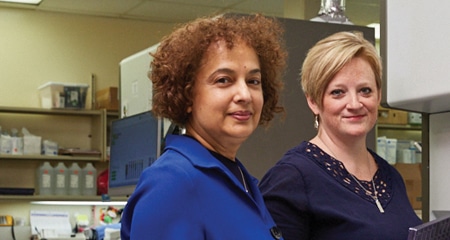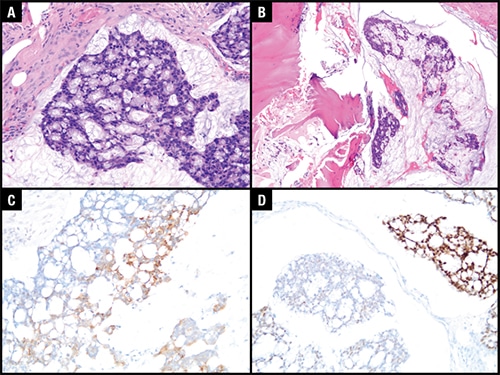September 2019—Talk to a few anatomic pathology laboratory directors about automation, and you may hear references to early network television, when automation’s downsides were mined for comedy. In one interview with CAP TODAY, a lab director drew parallels between potential backups in the automated AP lab and Lucy and Ethel’s travails keeping pace with a chocolate factory conveyor belt. There is strong agreement, to state it in 1960s TV terms, that even for core or centralized AP labs with the necessary volume, the traditional automation options have progressed well beyond the modern Stone Age, but reaching Tomorrowland may require a shift in thinking.
Read More »September 2019
Shifting trends test labs’ financial mettle
September 2019—There’s nothing new about lab and pathology reimbursement cuts that threaten bottom lines. Over the past three or four decades they’ve become essentially part of the wallpaper in health care.
Read More »New requirements for molecular micro waived testing
September 2019—Four new checklist requirements for waived molecular-based microbiology tests have been added to the CAP point-of-care testing, limited service laboratory, and immunology accreditation program checklists, as part of the 2019 checklist edition released this month.
Read More »Laboratory 2.0: teaming up against opioid use disorder
September 2019—Laboratory pharmacists are a rare breed. When Monique Dodd, PharmD, PhC, MLS(ASCP), spoke at the Executive War College this year, she joked that a third of the laboratory pharmacists in the country might be in the audience.
Read More »Better than glass slides? Digital pathology’s challenge
September 2019—The FDA’s clearance this year of a second digital pathology system for primary diagnosis is likely to lead to lower costs and greater innovation and interoperability, say digital pathology advocates. A multicenter study led the FDA in May to clear Leica Biosystems’ Aperio AT2 DX System for clinical diagnosis in the United States.
Read More »Up-front on PAMA impact, private payer pricing
September 2019—I’m going to talk about our experience over the past couple of years with PAMA, which seeks to produce market pricing, and some of the lessons we’ve learned. We all know how we got here and one of the questions has always been: Did we ever have market pricing? The answer is probably not. When you’re dependent on a 30-plus-year-old fee schedule that never was revised for technology revisions, there wasn’t market pricing to begin with. And at the end of all of what we’re experiencing, we still don’t quite have it.
Read More »Rapid assay detects HIV, syphilis simultaneously
September 2019—The results of a clinical trial of a rapid assay for dual detection of HIV and syphilis were reported at the 2019 HIV Diagnostics Conference in March. If approved by the FDA, where it has been under consideration since 2018, the Chembio Diagnostic Systems assay would be the first point-of-care assay of its kind on the U.S. market.
Read More »AMP case report: NGS of a rare metastatic bladder adenocarcinoma
September 2019—Primary bladder adenocarcinoma is a rare vesicle malignancy accounting for up to two percent of malignant neoplasms of the bladder.1 They occur in males more than females and are classically seen in the fifth or sixth decade of life.2 Histologically they are of enteric, mucinous, or mixed types. Morphologically, the enteric type appears identical to a colonic adenocarcinoma and the mucinous type appears as neoplastic cells floating in pools of extravasated mucin. The mixed type is a mixture of the morphologies of the enteric and mucinous types. Immunohistochemically, adenocarcinomas of the urinary bladder classically express CK20 and CDX2.
Read More »Put It on the Board
AACC panel votes Inflammatix technology most disruptive
September 2019—Inflammatix, a molecular diagnostics company, received the American Association for Clinical Chemistry’s Disruptive Technology Award at the AACC annual meeting in August. The company, in Burlingame, Calif., won for its rapid HostDx tests. The award was based on Inflammatix’s presentation during the meeting. It was one of three finalists selected to present to a panel of expert judges during a special session. “We’re developing rapid tests that read the immune system to improve disease diagnosis and are initially focused on developing tests for acute infections and sepsis, which are two of the biggest public health challenges of our time,” Tim Sweeney, MD, PhD, Inflammatix cofounder and chief executive officer, told CAP TODAY. The company’s first test, HostDx Sepsis, measures the expression of multiple immune genes to determine rapidly if a patient has a bacterial or viral infection and whether the patient has or is likely to develop sepsis, Dr. Sweeney said.
Q&A column
Q. Is there clinical value in doing routine manual band counts to detect infection in newborns, especially since procalcitonin and immature neutrophil counts are available? Read answer. Q. Can CoQ10 supplements affect the level of Coumadin (that is, the INR)? Read answer.
Read More »From the President’s Desk: A summit, a park, and parting words
September 2019—The CAP will sponsor next May the Pathologists Leadership Summit in Washington, DC. This is not just another meeting where you’ll learn to deal with changes happening around you that feel as if they are out of your control. No. This is a radical reinvention of a meeting where members will come together to achieve something specific—and move pathology forward.
Read More »Newsbytes
September 2019—It’s a simple and nearly airtight communication strategy: Tell someone something verbally and then share the same message with them in writing to make sure they understood you. Following this logic, a group of surgical pathologists at the University of Minnesota Medical Center made an assumption that if their intraoperative consultation results were made available to surgeons in written form during surgery as documentation of verbal communication—either in person or via telephone—the frequency of communication errors would be reduced.
Read More »Clinical pathology selected abstracts
September 2019—Pathologists play a critical role in patient diagnosis, and a shortage of pathologists may result in overwork, diminished quality of work, diagnostic errors, and delay in diagnosis. The authors of this study examined trends in the total U.S. pathologist workforce, using the Canadian pathologist workforce as a reference.
Read More »Anatomic pathology selected abstracts
Validation of 2016 ITBCC recommendations for tumor budding in stages I–IV colorectal cancer
September 2019—Tumor budding is a robust prognostic parameter in colorectal cancer and can be used as an additional factor to guide patient management. Although backed by large bodies of data, a standardized scoring method is essential for integrating tumor budding into reporting protocols.
Molecular pathology selected abstracts
September 2019—The pathologist’s ability to interpret the complex spatial organization within and between cells and intercellular matrices is the basic underlying principle of morphologic pathology. Even in the genomic era, molecular genetic information is not clinically useful without tissue context. Modern spatial capturing methods, either by low-fidelity light microscopy or high-fidelity electron microscopy, cannot concomitantly interrogate a nucleic acid sequence.
Read More » CAP TODAY Pathology/Laboratory Medicine/Laboratory Management
CAP TODAY Pathology/Laboratory Medicine/Laboratory Management









